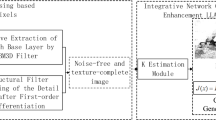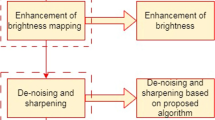Abstract
Application of deep learning techniques are limited in low-light scenarios. This is because lack of effective target regions makes it difficult to perform several visual functions in low intensity light. The objective of this work is to provide a framework for pedestrian recognition tasks in low-light conditions using image-to-image translation. The key idea behind is accumulation of high-quality information obtained by the combined use of infrared and visible images which make it possible to detect pedestrians even in low-light conditions. In this study, we are going to use deep learning-based models namely Pyramid pix2pixGAN and YOLOv7 to generate translated infrared images and detect pedestrians. The dataset used for training this model is LLVIP, the collection of visible-infrared image pairs for low light vision tasks. Our trained model is able to robustly detect pedestrians in low-light images and is able to beat previous state-of-the-art methods.
Access this chapter
Tax calculation will be finalised at checkout
Purchases are for personal use only
Similar content being viewed by others
References
Li C, Guo C, Han LH, Jiang J, Cheng MM, Gu J, Loy CC (2021) Low-light image and video enhancement using deep learning: A survey. IEEE Trans Pattern Anal Mach Intell 01:1–1
Haglund J, Jeppsson F, Melander E, Pendrill AM, Xie C, Schönborn K (2016) Infrared cameras in science education. Infrared Phys Technol 75:150–152
Jia X et al (2021) LLVIP: a visible-infrared paired dataset for low-light vision.“ Proceedings of the IEEE/CVF International Conference on Computer Vision
Shah V, Agarwal A, Verlekar TT, Singh R (2021) Adapting Deep Neural Networks for Pedestrian-Detection to Low-Light Conditions without Re-training. In: Proceedings of the IEEE/CVF international conference on computer vision, pp 2535–2541
Kruthiventi SS, Sahay P, Biswal R (2017) Low-light pedestrian detection from RGB images using multi-modal knowledge distillation. In: 2017 IEEE International Conference on Image Processing (ICIP), pp 4207–4211. IEEE
Wang C, Luo D, Liu Y, Xu B, Zhou Y (2022) Near-surface pedestrian detection method based on deep learning for UAVs in low illumination environments. Opt Eng 61(2):023103
Tian Y et al (2015) Deep learning strong parts for pedestrian detection.“ Proceedings of the IEEE international conference on computer vision
Jin Y, Zhang Y, Cen Y, Li Y, Mladenovic V, Voronin V (2021) Pedestrian detection with super-resolution reconstruction for low-quality image. Pattern Recogn 115:107846
Wang CY, Bochkovskiy A, Liao HY (2022) YOLOv7: Trainable bag-of-freebies sets new state-of-the-art for real-time object detectors. arXiv:2207.02696
Iqbal T, Ali H (2018) Generative adversarial network for medical images (MI-GAN). J Med Syst 42(11):1–11
Ouyang X, Cheng Y, Jiang Y, Li CL, Zhou P (2018) Pedestrian-synthesis-gan: Generating pedestrian data in real scene and beyond. arXiv:1804.02047
Sun J, Du Y, Li C, Wu TH, Yang B, Mok GS (2022) Pix2Pix generative adversarial network for low dose myocardial perfusion SPECT denoising. Quant Imaging Med Surg 12(7):3539
Liu S, Zhu C, Xu F, Jia X, Shi Z, Jin M (2022) BCI: Breast Cancer Immunohistochemical Image Generation through Pyramid Pix2pix. In: Proceedings of the IEEE/CVF Conference on Computer Vision and Pattern Recognition, pp 1815–1824
Shinde S, Kothari A, Gupta V (2018) YOLO based human action recognition and localization. Procedia computer science 133:831–838
Yang, F., Zhang, X., & Liu, B. (2022). Video object tracking based on YOLOv7 and DeepSORT. arXiv preprint arXiv:2207.12202.
Wang CY, Alexey B, Hong-Yuan Mark L (2022) “YOLOv7: Trainable bag-of-freebies sets new state-of-the-art for real-time object detectors. arXiv:2207.02696
Takeshita H, Ishii D, Okamoto S, Oki E, Yamanaka N (2011) Highly energy efficient layer-3 network architecture based on service cloud and optical aggregation network. IEICE Trans Commun 94(4):894–903
Paszke A, Gross S, Massa F, Lerer A, Bradbury J, Chanan G, Chintala S (2019) Pytorch: an imperative style, high-performance deep learning library. Advanc Neural Informat Process Syst 32
Isola P, Zhu JY, Zhou T, Efros AA (2017) Image-to-image translation with conditional adversarial networks. In Proceedings of the IEEE conference on computer vision and pattern recognition, pp 1125–1134
Goodfellow I, Pouget-Abadie J, Mirza M, Xu B, Warde-Farley D, Ozair S, Courville A, Bengio Y (2014) Generative adversarial nets. Advanc Neural Informat Process Syst 27
Author information
Authors and Affiliations
Corresponding author
Editor information
Editors and Affiliations
Rights and permissions
Copyright information
© 2023 The Author(s), under exclusive license to Springer Nature Singapore Pte Ltd.
About this paper
Cite this paper
Patel, D., Patel, S., Patel, M. (2023). Application of Image-To-Image Translation in Improving Pedestrian Detection. In: Pandit, M., Gaur, M.K., Kumar, S. (eds) Artificial Intelligence and Sustainable Computing. ICSISCET 2022. Algorithms for Intelligent Systems. Springer, Singapore. https://doi.org/10.1007/978-981-99-1431-9_37
Download citation
DOI: https://doi.org/10.1007/978-981-99-1431-9_37
Published:
Publisher Name: Springer, Singapore
Print ISBN: 978-981-99-1430-2
Online ISBN: 978-981-99-1431-9
eBook Packages: Intelligent Technologies and RoboticsIntelligent Technologies and Robotics (R0)




